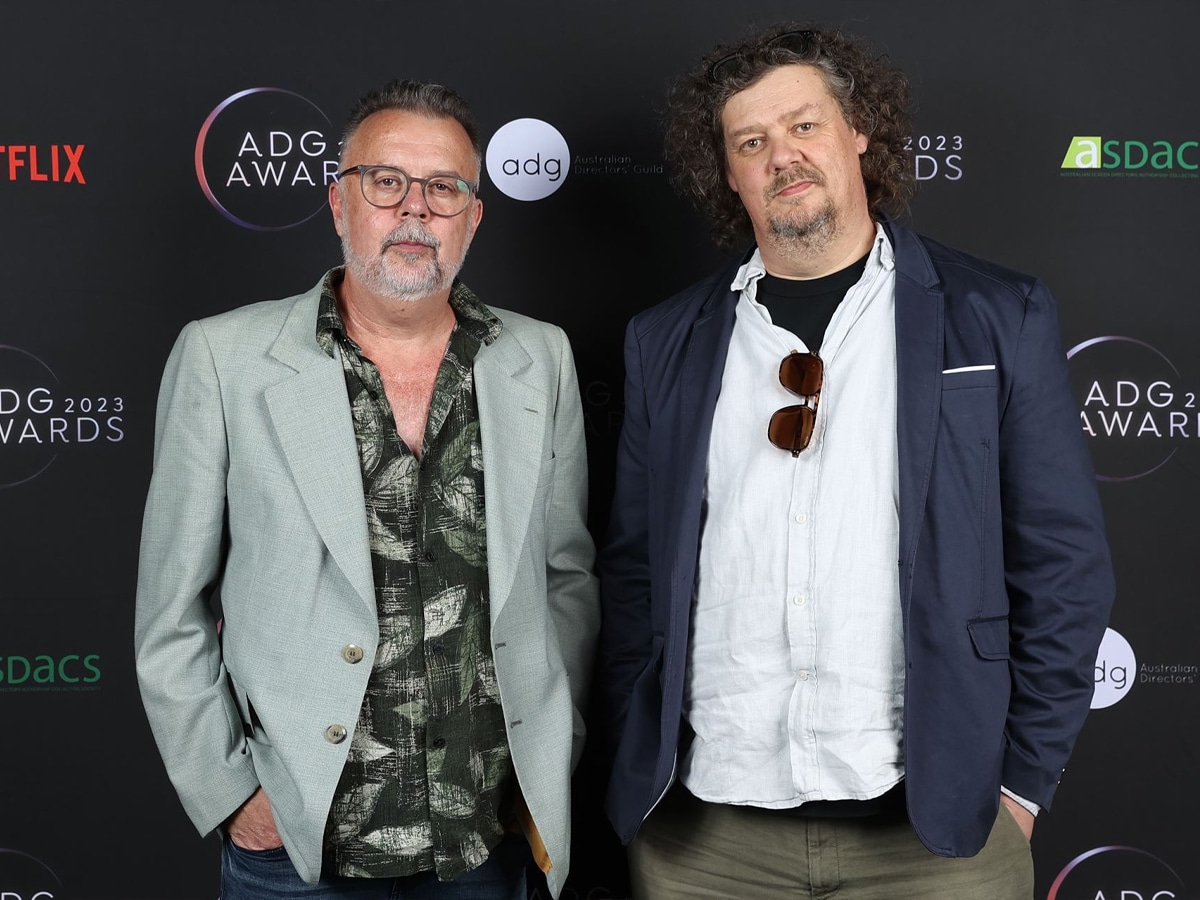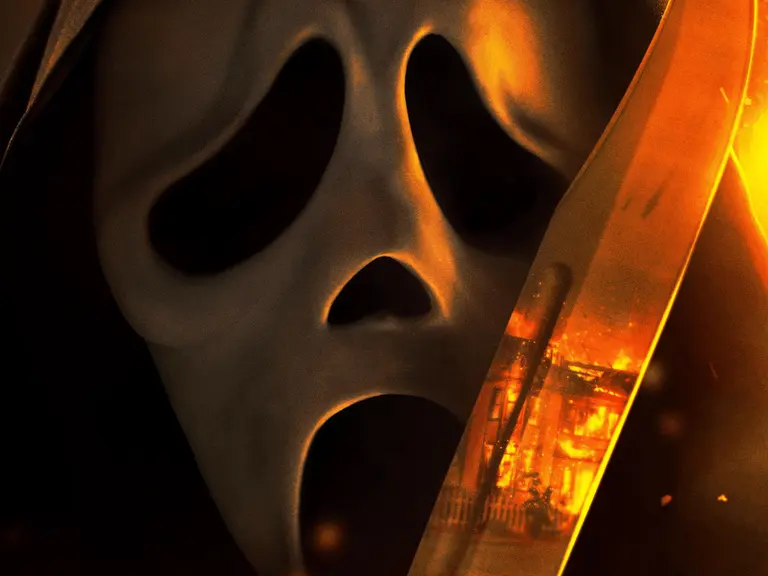When Aussie brothers Colin and Cameron Cairnes’ Ozploitation debut 100 Bloody Acres, about a pair of fertilizer manufacturers who resort to using human remains, was nominated for two AACTA Awards, a new horror powerhouse was born. The writing/directing duo followed up their surprise success with Scare Campaign, another blood-soaked tale, about a hidden camera prank show gone wrong. It earned them the Crystal Monster at Australia’s Monster Fest in 2015 – along with Best Director, Best Screenplay, and Best Sound. Now, the brothers are ready to wreak havoc in their third cinematic offering, a harrowing homage to the late-night talk shows and horror movies of their youth.

Inspired by the horror films they love – think filmmakers like De Palma, Carpenter, Cronenberg and Friedkin – the Cairnes brothers have combined the supernatural with the once unchecked spontaneity of live television. Tapping into the paranoia of an occult-obsessed 1970s America, their latest film Late Night with the Devil presents itself as a documentary that reveals long-lost footage from a fateful night of terrifying television.
On Halloween night in 1977, Johnny Carson rival Jack Delroy (David Dastmalchian) leads his syndicated late-night talk show Night Owls in an unforgettable Halloween special and unwittingly unleashes evil into American living rooms. The film premiered at SXSW in 2023 with Stephen King tweeting, “It’s absolutely brilliant. I couldn’t take my eyes off it.” Since then, the unique take on the found footage genre has played at festivals around the world, including the Sydney Film Festival.
Already out in U.S. theatres, Late Night with the Devil became distributor IFC Films’ largest opening weekend ever, summoning a scary good $2.8 million and landing number six (six six?) on the box office chart. Arriving on Shudder on 5 April and in Australian theaters on 11 April, this ghoulish good time from the producers of Paranormal Activity and Barbarian stars acclaimed character actor David Dastmalchian in his first major leading role.
Dastmalchian has built a career on solid (and frequently sinister) supporting roles in films such as The Dark Knight, Prisoners, Ant-Man, The Suicide Squad, Dune, and Oppenheimer. Hot as hell off its box office success, Late Night with the Devil is destined to become a Halloween tradition for fright fiends. I recently had the pleasure of talking with writers/directors Colin and Cameron Cairnes about their new nightmare and the nostalgia of ’70s horror.
This is a really fun horror film and the story is actually rooted in your childhood, watching late night talk shows.
Cameron Cairnes: We didn’t have Johnny Carson or Dick Cabot grace our screens as kids, but we had our own versions of those guys, our homegrown Australian versions, although one of the main ones happened to be an American, Don Lane, who we…
Colin Cairnes: Embraced as one of our own.
Cameron Cairnes: His show had a big impact on the writing of the film, that’s for sure. Also we looked at a lot of Carson and Cabot on Youtube and video.
Colin Cairnes: They’ve all found their way into the character of Jack Delroy. I think elements of all those guys. I think with David in the role, he’s created very much his own character.
I’d love to hear more about the ‘look book’ you created and sent to David Dastmalchian to pitch him on the project, as well as your collaboration with him.
Colin Cairnes: We knew some visual material would help get people’s attention, so the thought was that we would create this faux TV guide from the week prior to this Halloween special. So it was about the upcoming Halloween Sweeps week as well. We wrote a whole bunch of articles relevant to the period, and there was a feature article on Jack Delroy, an interview with him, and we managed to get a shot of David on the front cover. We had crosswords from the period and we made up a bunch of ads.
We really went to town, but yeah, it was effective. It’s hard to get people to read stuff. I think that was the thing that opened the door. It’s like, “Okay, these guys have got a clear picture of the look, the aesthetic, and the tone of it.” Even the stuff we’d written, we agonised over it. That was all pretty detailed and had a lot of clues as to his character and the Night Owls universe. That got his attention. He cracked open the script and a week later we were Zooming with him, and a little bit later, he was signed on. We’re still pinching ourselves that he agreed to do it.

You shot in Melbourne at Dockland Studios. What was that experience like?
Cameron Cairnes: We hadn’t shot in a studio before and I have to say, it was wonderful not having to worry about the weather or move around every day. It’s very tiring. I mean this was tiring in its own way, and a little bit maddening stepping onto the same set day in and day out.
Colin Cairnes: Those colours are very Seventies, and they work, but to be confronted with that colour palette every day for five weeks was overwhelming at times. The location was perfect because it is a TV studio. I think we managed to get a little window between two seasons of “Who Wants to Be a Millionaire?” or that sort of a show. It’s set up for TV, so we had the bleachers, we had as much ’70s-period lighting as possible. It felt like you were stepping into a ’70s time capsule when you walked into the studio, so that really helped us with the direction, but also for the actors as well, to feel like they’d stepped back in time.
There’s something about the combination of practical effects and visual effects that retains a grounded world for the audience.
Cameron Cairnes: Yeah, I think it was always really important that we incorporated practical effects. We’re big fans of practical effects. When I was a kid, growing up, I wanted to be a special makeup effects artist. Whenever we get the opportunity to splash the real thing around – blood and viscera – we’re there. There were plenty of moments to do that on this film.
Colin Cairnes: It felt right to us. For a film that was inspired by horror movies of that period, that we should be true to the look and feel of those films. If it was all CGI stuff, which we’re kind of opposed to in general anyway, it would just take it out of that period. You’d be much more conscious of it being a contemporary take. We just want people to feel immersed in that time. So if that meant some ‘less than seamless’ practical effects, that’s fine, because that’s the way it was. But I think people always appreciate the work that’s gone on to capture that in camera.

You’re very limited with time and money, and not everything goes exactly the way you want. So you end up having to augment things occasionally, and we’ve done that. That’s what all films do, but I think there’s a lot less of it in this film than your average genre pick.
– Colin Cairnes
Growing up in Brisbane, what were your formative years in horror like?
Colin Cairnes: Who told you about Brisbane? You’ve done your research.
Cameron Cairnes: Well, Brisbane, you know it’s funny we were just looking at all VHS cassettes from that time, and we discovered the Queensland edit of Re-Animator. Horror films, in particular, would get heavily censored. So we never knew if we were seeing the correct version of something. Like Re-Animator, for instance, there was so much gore taken out that they had to put back in all these scenes that had ended up on the cutting room floor. I mean, they’re good scenes, but it’s just such a different film because of the censors trying to make something that was going to be palatable to the Queensland audience.
Colin Cairnes: It was a very conservative state. We don’t need to get into Australian history and politics too much, but it was a very, very conservative place. We had a governor, as it were, who ran the state for about 30 years. He kept getting voted in because of gerrymandering. He would ban record shops, bookshops. Any gathering of more than three people was kind of illegal, it was full on, actually, in the ’70s. In the ’80s, it started to get a bit better. For us, watching those films, now that you bring it up, maybe there was kind of an active rebellion involved in it, because it was such a conservative place. We’d do anything we could to get access to these films. You’d read about the uncensored versions that America might see and we’d be pining to get our hands on that stuff.

I loved all of the horror references, like Vincent Price, the Warrens, and all the little horror nuggets you embedded in the film.
Colin Cairnes: Yeah, it’s a little homage to all the stuff that we love. It was the Warrens’ period; the Seventies is when they were doing the talk show circuits, Amityville, and all of that, so it just felt right.
Cameron Cairnes: And of course David’s an enormous Vincent Price fan, so he loved all that. He snuck in a few of his own references to Berwyn, Illinois, the home of Svengoolie.
I also love horror movies that don’t rely on jump scares. Some of the most unsettling moments in the movie are blink-and-you-miss-it.
Colin Cairnes: Yeah, hopefully there’s enough there for a repeat viewing or two. I think the film actually starts to get good on about the third viewing [Laughs.]
Cameron Cairnes: [Laughs.] It all starts to make sense.
Colin Cairnes: Then it falls apart for the next two and then becomes good again for number six.
Cameron Cairnes: There’s a bit going on in the background. Obviously The Exorcist was a little bit of an influence on that and how they use some of that subliminal imagery to freak the peeps out.
Colin Cairnes: But yeah, you’re right, there aren’t many classic jump scares in it. We didn’t think it was that kind of story. These days a horror movie has to open with a jump scare, basically.
Cameron Cairnes: We didn’t really have the environment for it, because the set is so open, there’s nowhere to hide and nowhere for anyone to sort of jump out from.
Colin Cairnes: I guess our cheat jump scare is the one where Jack jumps out and scares Gus. It’s the comic jump scare.
We’re creeping up on the halfway to Halloween mark. I can’t think of a more perfect film for that.
Colin Cairnes: Yeah, we’re just excited for the film to be out there. Hopefully as many people get down to see it as possible. And then, of course, we arrive on Shudder in April, which is exciting too.
Late Night With the Devil is written and directed by Colin and Cameron Cairnes. Image Nation Abu Dhabi presents in association with VicScreen, AGC Studios, and Good Fiend Films, a Future Pictures and Spooky Pictures production. You can catch it in U.S. theaters now, on Shudder 5 April, and in Australian cinemas 11 April.

































Comments
We love hearing from you. or to leave a comment.